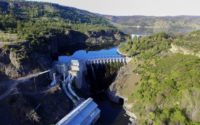Large Dam Go-Ahead Releases Pent-Up Protests
The battle of Belo Monte came to the headquarters of Brazil’s National Electric Energy Agency, Aneel, in Brasília on April 20. While government and business leaders convened inside, hundreds of protesters gathered in the streets.

In response to the project being awarded inside the National Electric Energy Agency building, vocal protesters dumped hundreds of pounds of horse manure onto its steps.
The project has become a flashpoint for the need to conserve the vast but fragile Amazon as well as meet the country’s growing energy needs. Caught in the middle of the conflict are hundreds of indigenous groups whose homes and livelihoods are threatened with inundation.
An estimated 20,000 people, including 800 native Indians, are projected to be affected by the project.
The project has been a magnet for celebrity protestors since it was initially proposed in the 1980s. Rock star Sting was on hand for protests in 1989 aimed at blocking IMF funding of the proposed dam. The efforts were successful in having the effort shelved.
Opposition to the scheme in the 1980s focused on pressuring international lenders to keep them from providing financing. The country’s subsequent economic growth has removed that particular hurdle. Brazil’s national development bank, BNDES, said in late April that it will finance as much as 80% of the project.
The new incarnation of the dam on the Xingu River has attracted a new wave of foreign celebrities to the cause. Hollywood director James Cameron compared the plight of the indigenous tribes in the region with the protagonists of his recent blockbuster movie, “Avatar.”
Activist groups already are planning protests in towns that will be affected by the reservoir, and Indians have begun establishing a permanent village on the site of the proposed dam to block construction.
They vow to use violence, if necessary.
“There will be bloodshed, and the government will be responsible for that,” said Luis Xipaya, a leader of one of the tribes that would be affected.
In a letter to the president last year, a federation of 14 Amazon tribes warned of “warlike actions” to defend their land if construction commenced.
The indigenous groups insisted that the dam would violate the “rights of the river’s ancestral peoples” and that the government would be responsible for any violence that occurred in residents’ defense of their land.
In light of past incidents between government officials and the native tribes, the threat gives pause.
An employee of the state electric company Eletrobras was wounded in a confrontation with machete-wielding Indians in May 2008 during a seminar to explain the dam project to the local communities.
A similar incident occurred in a presentation to promote the dam in 1989 when a Kayapo Indian held a hunting knife against the neck of an Eletrobras employee. That employee, Jose Antonio Muniz, is the head of the power company today.



